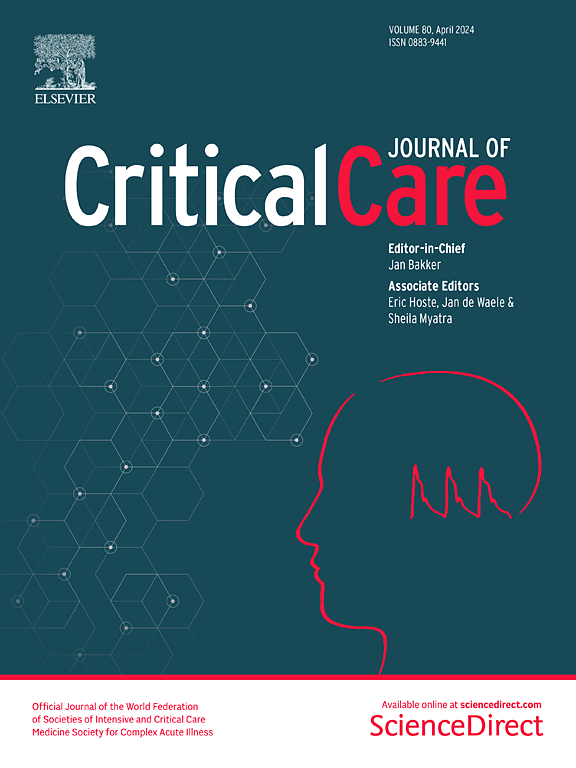Weaning of non COPD patients at high-risk of extubation failure assessed by lung ultrasound: the WIN IN WEAN multicentre randomised controlled trial
IF 8.8
1区 医学
Q1 CRITICAL CARE MEDICINE
引用次数: 0
Abstract
Postextubation respiratory failure (PRF) frequently complicates weaning from mechanical ventilation and may increase morbidity/mortality. Noninvasive ventilation (NIV) alternating with high-flow nasal oxygen (HFNO) may prevent PRF. Ventilated patients without chronic obstructive pulmonary disease (COPD) and at high-risk of PRF defined as a lung ultrasound score (LUS) ≥ 14 assessed during the spontaneous breathing trial, were included in a French-Chinese randomised controlled trial. PRF was defined by 2 among the following signs: SpO2 < 90%; Respiratory rate > 30 /min; hypercapnia; haemodynamic and/or neurological disturbances of respiratory origin. In the intervention group, prophylactic NIV alternating with HFNO was administered for 48 h following extubation. In the control group, conventional oxygen was used. Clinicians were informed on the LUS in the intervention group, those in the control group remained blind. The primary outcome was the incidence of PRF 48 h after extubation. Secondary outcomes were incidence of PRF and reintubation at day 7, number of ventilator-free days at day 28, length of ICU stay and mortality at day 28 and 90. Two hundred and forty patients were randomised and 227 analysed (intervention group = 128 and control group = 99). PRF at H48 was reduced in the intervention group compared to the control group: relative risk 0.52 (0.31 to 0.88), p = 0.01. The benefit persisted at day 7: relative risk 0.62 (0.44 to 0.96), p = 0.02. Weaning failure imposing reconnection to mechanical ventilation was not reduced. In patients who developed PRF and were treated by rescue NIV, reintubation was avoided in 44% of control patients and in 12% of intervention patients (p = 0.008). Other secondary outcomes were not different between groups. From a resource utilisation standpoint, prophylactic NIV alternating with HFNO was more demanding and costly than conventional oxygen with rescue NIV to achieve same clinical outcome. Compared to conventional oxygenation, prophylactic NIV alternating with HFNO significantly reduced postextubation respiratory failure but failed to reduce reintubation rate and mortality in patients without COPD at high risk of extubation failure. Prophylactic NIV alternating with HFNO was as efficient as recue NIV to treat postextubation respiratory failure.通过肺部超声波评估非慢性阻塞性肺病高风险拔管失败患者的断奶情况:WIN IN WEAN 多中心随机对照试验
拔管后呼吸衰竭(PRF)经常使机械通气断奶复杂化,并可能增加发病率/死亡率。无创通气(NIV)与高流量鼻氧(HFNO)交替使用可预防 PRF。一项中法随机对照试验纳入了无慢性阻塞性肺病(COPD)的通气患者和 PRF 高危患者,PRF 的定义是在自主呼吸试验中评估的肺超声评分(LUS)≥ 14。PRF 的定义为以下体征中的两个:SpO2 30 /min;高碳酸血症;血流动力学和/或神经系统呼吸紊乱。干预组在拔管后 48 小时内使用预防性 NIV,并交替使用高氟硝酸。对照组则使用常规氧气。干预组的临床医生会被告知 LUS 的情况,而对照组的临床医生仍然是盲人。主要结果是拔管 48 小时后 PRF 的发生率。次要结果是第 7 天的 PRF 和再次插管发生率、第 28 天的无呼吸机天数、重症监护室住院时间以及第 28 天和第 90 天的死亡率。240 名患者接受了随机治疗,其中 227 人接受了分析(干预组 128 人,对照组 99 人)。与对照组相比,干预组在 H48 时的 PRF 有所降低:相对风险为 0.52(0.31 至 0.88),P = 0.01。这种益处在第 7 天时依然存在:相对风险为 0.62(0.44 至 0.96),P = 0.02。重新连接机械通气的断奶失败率并未降低。在出现 PRF 并接受 NIV 治疗的患者中,44% 的对照组患者和 12% 的干预组患者避免了再次插管(p = 0.008)。其他次要结果在组间没有差异。从资源利用的角度来看,要达到相同的临床效果,预防性 NIV 与高频硝化甘油交替使用比传统吸氧与抢救性 NIV 的要求更高,成本也更高。与传统吸氧相比,预防性 NIV 与高频硝化甘油交替使用可显著减少拔管后呼吸衰竭的发生,但对于无慢性阻塞性肺病且拔管失败风险较高的患者来说,却无法降低再插管率和死亡率。在治疗拔管后呼吸衰竭方面,预防性 NIV 与高频硝化甘油交替使用与再次 NIV 一样有效。
本文章由计算机程序翻译,如有差异,请以英文原文为准。
求助全文
约1分钟内获得全文
求助全文
来源期刊

Critical Care
医学-危重病医学
CiteScore
20.60
自引率
3.30%
发文量
348
审稿时长
1.5 months
期刊介绍:
Critical Care is an esteemed international medical journal that undergoes a rigorous peer-review process to maintain its high quality standards. Its primary objective is to enhance the healthcare services offered to critically ill patients. To achieve this, the journal focuses on gathering, exchanging, disseminating, and endorsing evidence-based information that is highly relevant to intensivists. By doing so, Critical Care seeks to provide a thorough and inclusive examination of the intensive care field.
 求助内容:
求助内容: 应助结果提醒方式:
应助结果提醒方式:


